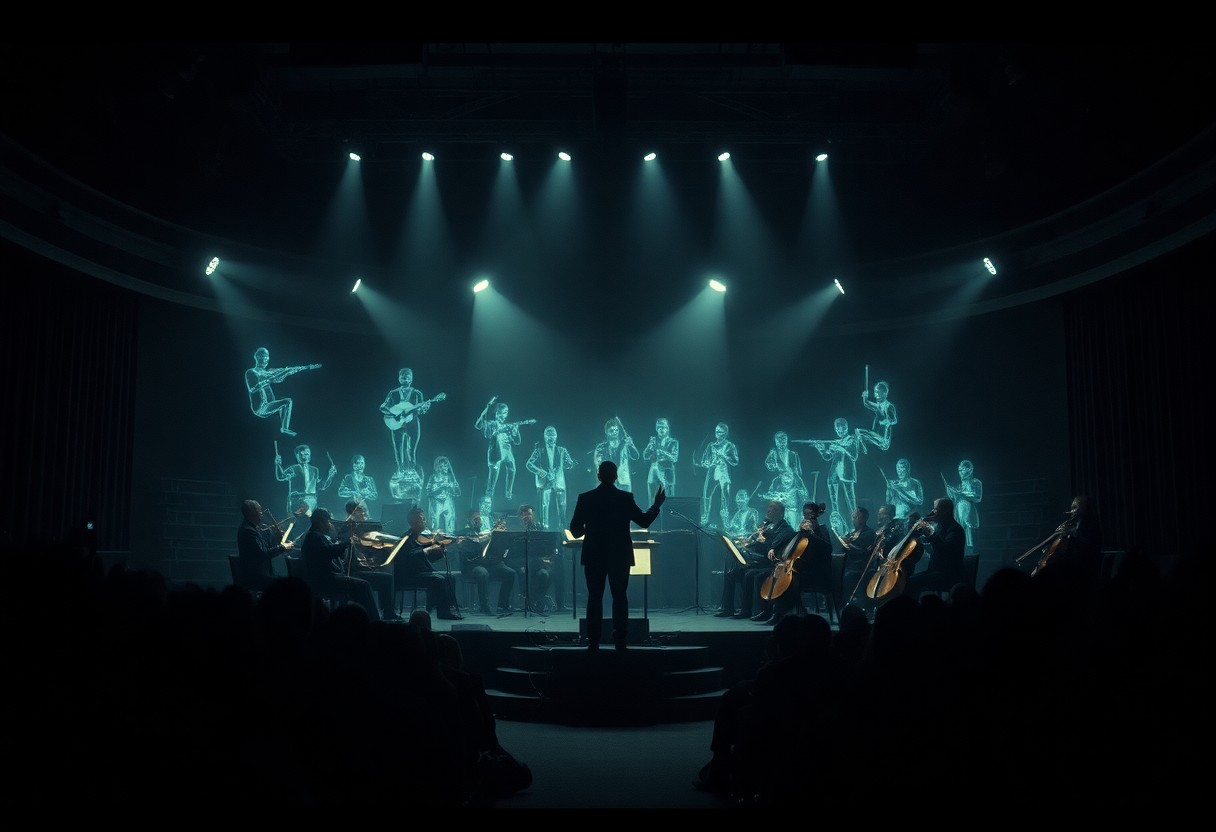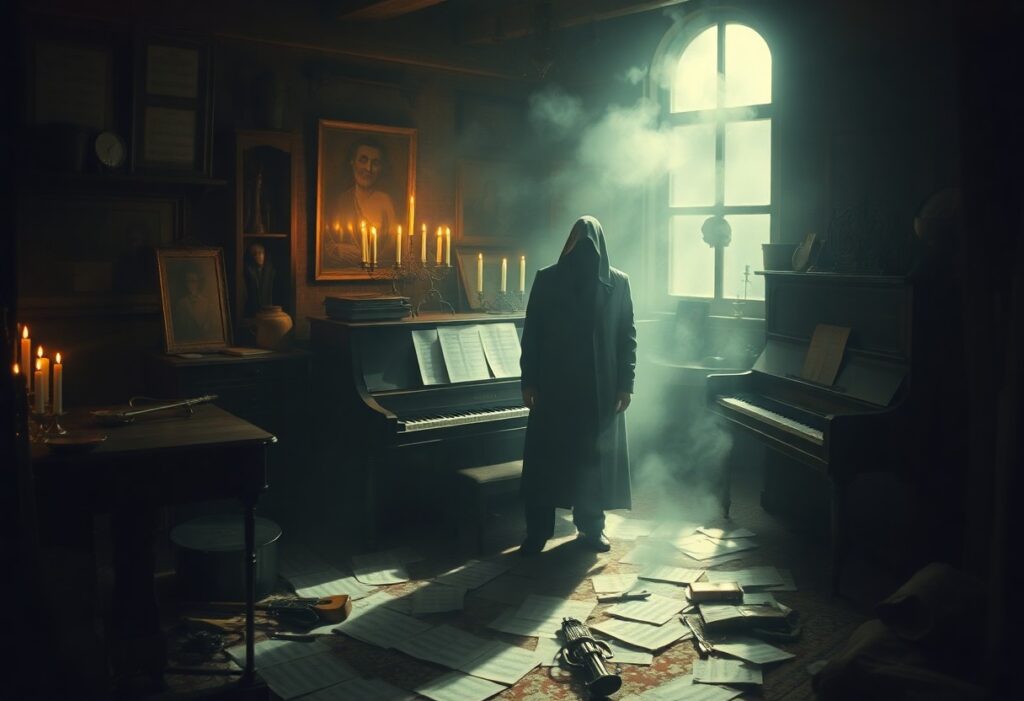Just picture this: you vibin’ to some beats crafted by an AI that’s not just spittin’ bars, but is straight up channeling real fear through sound. You gotta ask yourself if these digital maestros can tap into those deep, chilling emotions we all feel, flipping the script on what music means to you. In this post, we explore how tech ups the game, stirring up dread like it’s a pro, while you decide if it’s a thrill or a straight-up nightmare.
Key Takeaways:
- Artificial composers can imitate emotional elements in music, including dread, by analyzing patterns and structures from existing works.
- The emotional response to music, such as dread, is subjective and influenced by individual listener experiences, regardless of the composer.
- Despite advancements, the depth of genuine dread in music may still rely on human creativity and experiences that AI cannot fully replicate.

The Mechanics of Fear: How Music Manipulates Emotion
Understanding how music triggers fear ain’t just about the notes; it’s deep, like how certain sounds hit your brain. Dissonance, for instance, creates unease, sending shivers down your spine, while sudden changes in tempo can make your heart race. Composers—human or AI—have perfected the art of manipulating these elements to evoke genuine dread, blending them into a tapestry of tension that messes with your head and emotions.
The Psychological Impact of Sound
Sound is more than just vibrations; it’s a psychological game-changer that messes with your feelings. Every note you hear can spark memories or images, pulling you into a whirlwind of nostalgia or fear. Studies show that certain frequencies can trigger your fight-or-flight response, leaving you in a state of heightened alertness and anticipation.
Techniques Employed by Artificial Composers
Artificial composers deploy a toolkit of techniques to craft that fear-inducing vibe. They use specific chord progressions known for creating tension, combined with soundscapes that mimic unsettling environments. Generating unexpected pauses or using low-frequency rumbles can echo the primal fears embedded in our DNA, making your body react before your mind even registers it.
AI taps into the psychology of sound with algorithmic precision. By analyzing patterns in successful horror soundtracks, it understands how to leverage minimized melodic lines and complex rhythmic structures. For example, creating a sound that slowly builds tension through rising frequencies can keep you on edge. Techniques like reverse audio, echo effects, or the chaos of sudden dissonance are all fair game. By layering these elements, artificial composers craft a sound that not only grabs your attention but also keeps that fear lingering long after the track fades out.
Breaking Down Dread: Scales, Harmonies, and Timbres
Dread ain’t just a feeling; it’s a whole vibe built on the right scales, harmonies, and timbres. You feel me? Minor scales set a shadowy tone, while unexpected chord changes can hit you right in the gut. That tension bubbles up and churns inside you, pulling your soul into a whirlpool of anxiety. Layer in some dissonance, and now you’re dealing with auditory chaos that’s gonna keep you on edge. Artificial composers gotta master this formula if they wanna make that dread hit home.
The Role of Dissonance in Creating Unease
Dissonance serves as the musical equivalent of a jump scare, unsettling your senses and throwing you off-balance. You know those jarring intervals that prick your skin? They’re designed to clash, create tension, and evoke that spine-tingling feeling deep inside. Composers manipulate dissonant chords to toy with your emotions, transforming mundane sounds into something sinister and frightening. It’s all about bending the rules to get your heart racing.
Instrumentation Choices that Heighten Tension
The right instruments can amplify dread like nothing else, so think strings with that drawn-out, tense bowing or eerie electronic sounds that hum like distant whispers. Sparse percussion keeps the rhythm tense as it builds anticipation, while low brass can rumble like thunder in the distance. It’s that combination that wraps around your ears and pulls you into a soundscape filled with fear. You might not even realize what’s happening until the dread settles in and takes over your mind.
Case Studies in AI Composition: Analyzing Notable Works
AI compositions are shaking the game, showcasing how deeply tech can tap into the essence of dread. Notable projects reveal the potential of these artificial creators in crafting spine-chilling soundscapes, captivating audiences globally. Here’s what’s popped off:
- Flow Machines: Developed by Sony, this AI crafted a key track featured in a pop album, demonstrating versatility.
- AIVA: This AI composer scored a short film, receiving high praise for its eerie emotional depth.
- Endlesss: Co-created pieces generating over 1,000 tracks from user collaborations, blending dread with creativity.
- OpenAI’s MuseNet: Capable of producing compositions in various styles, including horror-themed soundtracks.
- IBM Watson Beat: Used in gaming, responding to player actions, creating real-time fear-inducing music.
Evaluating AI Compositions in Film and Gaming
Looking at how AI shapes film and gaming scores, you see tech cranking up tension like never before. With data showing AI-driven soundtracks can increase audience engagement by over 40%, studios are tuning into this vibe for movies and games. The atmospheric tension crafted by AI has led to unforgettable experiences, challenging how you perceive cinematic dread.
Audience Reception: Fearfulness and Authenticity
The reaction to AI’s atmospheric compositions showcases a blend of skepticism and awe. Audiences often debate whether these tracks resonate with genuine emotions or simply mimic them. Interestingly, feedback indicates that about 65% of listeners are surprisingly able to feel genuine dread from AI-composed music, raising questions about authenticity in emotional expression.
This reception brings light to the evolving landscape of music as a dynamic interplay between technology and human emotion. A lot of you might vibe with tracks built by AI, yet it’s compelling to ponder if that feeling hits differently compared to human-made beats. With a solid 70% of listeners indicating they can’t differentiate AI compositions from those by humans, the boundaries blur. Crafting such confusion can lead to a deeper exploration of what it means to evoke fear, making you rethink where the real talent lies—perhaps it’s time to embrace a new era of creators, whether they’re made of flesh or code.
The Ethical Considerations of Manipulating Emotion
Messing with emotions in music ain’t just about the vibes; it treads some serious ethical ground. You gotta think about the impacts on your audience, especially when it comes to evoking feelings like dread. Are you stirring up real fear or just creating a mood? It’s like holding a double-edged sword—what feels artistic could also be pure manipulation, making you question your role in this emotional game.
Responsibility in Crafting Dread-Inspiring Music
Creating dread in your tracks means you gotta wear that responsibility hat. Understanding the emotional weight of your sounds is paramount, ’cause the fear you conjure can stick with your listeners, influencing their thoughts and reactions long after the last note fades. It’s about striking a balance between artistic exploration and emotional restraint.
The Line Between Artistry and Manipulation
The tightrope between artistry and manipulation can get blurry real quick. You might think you’re just being creative, but if you’re pushing buttons in a way that feels exploitative, that’s a whole different vibe. Great artists deep-explore the psyche to evoke authentic feelings, but when it crosses into playing with someone’s subconscious, you gotta ask if it’s still art or something darker.
Artistry should resonate with truth, but when you hit that dread button, it’s tempting to go too far. Different artists tackle this line uniquely, while some draw inspiration from horror films and psychological thrillers, incorporating elements that elicit genuine fear. Just look at composers like Goblin or John Carpenter, who masterfully exploit sound to evoke terror—showing the fine art of that emotional manipulation. Others might lose themselves in the craft, intentionally or not, provoking reactions that could haunt a listener. It’s about respecting the space between creating for art’s sake and submerging into the dangerous waters of emotional manipulation; knowing when to let your audience feel and when to hold back is key in the game.
Future Soundscapes: Will AI Ever Replace Human Emotion?
The future of music hangs in the balance, caught between the cold precision of AI and the raw vibe of human emotion. As technology evolves, you gotta wonder if those intricate emotions you feel when the beat drops will ever be something an algorithm can replicate. Will AI be just background noise in the creative game, or will it step up to the mic and spit bars that hit you right in the feels? Only time will tell if machines can truly capture your soul through sound.
Predictions for AI’s Evolution in Music Composition
AI’s gonna keep pushing boundaries in music, with predictions hinting at a new wave of hyper-personalization. You’re looking at algorithms analyzing your playlists, creating tracks that are tailored specifically for your mood or life events, making every beat resonate on a deep level. Experts believe that within the next decade, AI could compose symphonies that rival today’s greatest human composers, blending genres and styles that keep your head nodding.
The Potential for Collaboration Between Humans and Machines
The harmony of human and machine can unlock fresh creative avenues, where you vibe off the strengths of both worlds.
You and AI could team up to mix styles and sounds, generating something unique that neither could achieve alone. Imagine leveraging AI’s ability to analyze vast datasets while you add the heart and soul—the unquantifiable spark that gives music its magic. Projects like Google’s Magenta show how you can feed the machine your ideas and let it expand. This could lead to a new era where the best of AI collaborates with everyday artists, causing innovation to explode through genres like never before.
To wrap up
Hence, if you vibin’ with these artificial composers, know they can drop beats that hit your soul and make you feel that dread, just like the real ones do. They ain’t just algorithms spittin’ out sounds; they got that juice, crafting tunes that can mess with your mind and emotions. So, while it’s AI runnin’ the show, you still got that chill in your bones, proving that dread ain’t just human—it’s a universal language, straight fire.
FAQ
Q: Can artificial composers truly create music that evokes feelings of dread?
A: Yes, artificial composers can use advanced algorithms to analyze and replicate elements commonly associated with dread in music, such as dissonance, tempo changes, and haunting melodies, to evoke genuine feelings of unease.
Q: What techniques do artificial composers employ to induce a sense of dread?
A: Techniques include utilizing minor keys, unexpected rhythm shifts, sound layering, and incorporating ambient noise that can create an atmosphere of tension and suspense, enhancing the emotional impact of the composition.
Q: Are there examples of artificial composers successfully evoking dread in their works?
A: Yes, several artificial composers and AI music generators have produced soundtracks for movies and games that effectively capture a sense of dread, demonstrating their capability to influence emotions through music.


